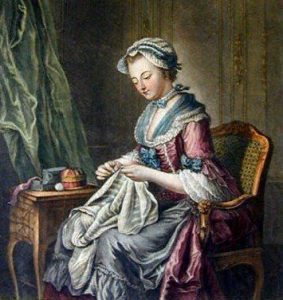Silk and Writing
 Liz Trenow, author of The Dressmaker of Draper’s Lane, published by Pan Macmillan on 21st February 2019.
Liz Trenow, author of The Dressmaker of Draper’s Lane, published by Pan Macmillan on 21st February 2019.
I have written six novels and four of them were inspired by a single thing: silk!
I was born and brought up next door to a silk mill in Sudbury, Suffolk. My family have been silk weavers for nearly 300 years, starting in Spitalfields in East London in 1720 before moving to East Anglia in the 19th century. It is the longest running silk company in Britain, probably one of the oldest of any kind, and is one of only three still working in the UK today, supplying top end fashion houses and interior designers all over the world. They wove the Queen’s Coronation robe and a number of royal wedding dresses including Princess Diana’s.
It was when I began to research the history of the company – talking to my father and uncle and many people who had worked for them – that I came across the wonderful fund of stories which have inspired many of my novels.
 My debut, The Last Telegram, is set in the house where I grew up and in the mill next door, during the years from 1939 onwards when they began weaving parachute silk. The main thread is the true story of how my father and uncle decided to sponsor five ‘Kindertransport’ boys – Jewish children allowed to leave Germany just before the start of WW2. The boys were trained as weavers but in 1940 were interned as ‘enemy aliens’ and transported to Australia.
My debut, The Last Telegram, is set in the house where I grew up and in the mill next door, during the years from 1939 onwards when they began weaving parachute silk. The main thread is the true story of how my father and uncle decided to sponsor five ‘Kindertransport’ boys – Jewish children allowed to leave Germany just before the start of WW2. The boys were trained as weavers but in 1940 were interned as ‘enemy aliens’ and transported to Australia.
One of them was determined to return to Britain because he had fallen in love with the girl at the Sudbury post office. He managed to get back, changed his name and signed up to fight for the Allies. After the war he married his sweetheart and returned to the mill as my father’s right-hand man and good friend – the man we knew as our ‘German uncle’.
The next book, The Forgotten Seamstress was inspired by a piece of silk that had been designed and woven for the wedding of Princess May (later to become Queen Mary) to King George V. The mystery is how this unique royal silk came to be included in a patchwork quilt created by a woman incarcerated in a mental hospital for most of her life.
The Forgotten Seamstress was a huge hit in America and reached the top twenty in the New York Times and US Today best seller lists. The pattern for ‘Maria’s Quilt’ was designed for me by the eminent quilter Lynn Edwards MBE, and even today I receive photographs of quilts made to that pattern by quilters all over the world!
I took a break from silk in 2014, writing a WW1 novel about shell shock – or PTSD as we know it today – called The Poppy Factory (recently published in the US as All The Things We Lost) but silk was calling me back. I had discovered the first known address of the family silk firm in Spitalfields, East London, and one bright winter day I went to visit it. I knocked on the door not expecting any answer, but the wonderful owner listened to my story and then invited me into her home.
Being a Grade 1 listed building, all of the Georgian features had been preserved and it was just like walking back in time, in the footsteps of my ancestors. I decided then and there that my next book would be set there, in the 18th century. Afterwards as I walked along the street I discovered a blue plaque marking the home of an eminent silk designer called Anna Maria Garthwaite who lived there at the same time as my family. They would have known each other.
Anna was both prolific (a thousand of her designs are held by the Victoria and Albert Museum) and highly popular, her designs commissioned by the wealthy both in the UK and in America. But no-one knows how an unmarried middle aged woman with no background in silk weaving learned her craft. It was a story begging to be told, and became The Silk Weaver, published in the UK and US (as The Hidden Thread) and in translation in a dozen other countries.
The protagonist of my latest novel, Miss Charlotte, arrived as a minor character in The Silk Weaver. I needed a go-between so that my heroine, a young society lady, could meet and fall in love with a lowly journeyman silk weaver. An unmarried, financially independent woman running her own business in the 18th century was extremely unusual. I couldn’t get her out of my head.
Although there were many jobbing seamstresses in the 18th century often working for pitiful wages, you were only allowed to employ others, and make real money, if you undertook an apprenticeship, and unless you were born into the trade, that would be expensive. So how did Miss Charlotte, a foundling, manage to set up her own business and why, when she seems to have everything, is Miss Charlotte not content with her life? An auction, a piece of silk, a strange feeling of recognition – these are what sets her on a quest to discover who she truly is.
So what next? Do I have any more silk stories ready to be turned into novels? Do I want to return to the world of 18th century silk weavers and high fashion? The answer to both is yes, but probably not yet. I’ve just written another WW2 novel which will be published in 2020, and an idea for the one after that. Neither of them feature silk. But it will always fascinate me, and I’m sure I won’t be able to resist returning to it one day.
—
Liz Trenow is a former journalist who spent fifteen years working for regional and national newspapers, and on BBC radio and television news, before turning her hand to fiction. The Dressmaker of Draper’s Lane, her sixth novel, has just been published in the UK. Her work has been published all over the world and translated into many languages. She lives in Colchester, Essex with her artist husband, and they have two grown up daughters and three grandchildren. Find out more at www.liztrenow.com and join her on Twitter @LizTrenow
About THE DRESSMAKER OF DRAPER’S LANE
 The Dressmaker of Draper’s Lane revisits the opulence and extravagance of the London silk trade in the mid-eighteenth century which Liz Trenow wrote about in her previous bestselling novel, The Silk Weaver.
The Dressmaker of Draper’s Lane revisits the opulence and extravagance of the London silk trade in the mid-eighteenth century which Liz Trenow wrote about in her previous bestselling novel, The Silk Weaver.
1768, London.
As a foundling who rose from poverty and now runs her own successful dressmaking business in the heart of society London, Miss Charlotte is a remarkable woman, admired by many. She has no need, nor desire, to marry. The people she values most are her friend Anna, her recently-found sister Louisa and nephew Peter.
She feels herself fortunate, and should be content with what she has. But something is missing.
A small piece of rare silk discovered in a bundle of scraps at auction triggers a curious sense of familiarity, and prompts her to unpick a past filled with extraordinary secrets and revelations . . .
Category: Contemporary Women Writers, On Writing
























